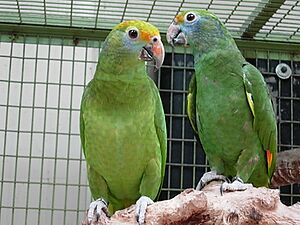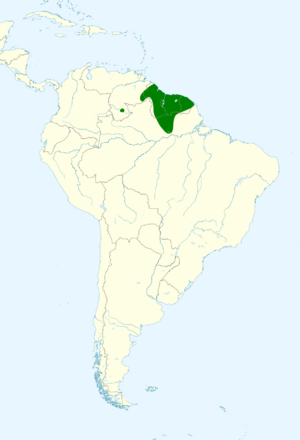Blue-cheeked amazon facts for kids
Quick facts for kids Blue-cheeked amazon |
|
|---|---|
 |
|
| Conservation status | |
| Scientific classification | |
| Genus: |
Amazona
|
| Species: |
dufresniana
|
 |
|
The Blue-cheeked Amazon (also known as the Blue-cheeked Parrot) is a special type of parrot. Its scientific name is Amazona dufresniana. This parrot lives in parts of South America, like Brazil, Guyana, Suriname, French Guiana, and Venezuela. It's considered a Near Threatened animal, which means it needs our help to protect it.
Contents
About Its Name and Family
Scientists group animals into families. The Blue-cheeked Amazon is unique and doesn't have any subspecies. This means it's the only one of its kind.
Long ago, some scientists thought it was a subspecies of other parrots. For example, the Red-browed Amazon was once thought to be a type of Blue-cheeked Amazon.
The name dufresniana was given to honor a French zoologist named Louis Dufresne.
What Does It Look Like?
The Blue-cheeked Amazon is about 34 to 37 centimeters (13 to 14.5 inches) long. It weighs between 481 and 615 grams (about 1 to 1.3 pounds). Both male and female parrots look very similar.
Most of their body is a bright green color. They have a bit of yellow on their forehead and a creamy color near their beak. The lower part of their face and sides of their neck are a pretty lavender-blue.
Their neck feathers have black edges, which makes them look like they have a cool, scalloped pattern. Their tail feathers are green with yellow tips. The outer wing feathers are black with blue, while inner ones are green with pale blue tips. Some outer wing feathers are bright yellow or orange.
Their eyes are dark, and their beak is dusky with a red base. Their legs and feet are gray. Young parrots look like the adults but have less blue on their heads. Their yellow crown is also not as bright.
Where Do They Live?
You can find the Blue-cheeked Amazon in eastern Venezuela. They also live across Guyana, Suriname, and French Guiana. They even go a little bit south into northern Brazil.
Scientists are still learning about their favorite places to live. In some areas, they like humid forests in lowlands and foothills. In other places, they might live in forests on coastal sand ridges for part of the year. They can be found from sea level up to about 1,700 meters (5,577 feet) high.
How Do They Behave?
Moving Around
Blue-cheeked Amazons usually stay in one area. However, some might move between the coast and inland areas in Suriname during different seasons. They often fly in groups of up to 30 birds. These groups are usually made up of only Blue-cheeked Amazons.
What Do They Eat?
These parrots mostly find their food high up in the forest trees. We don't know much about their exact diet. But like other Amazona parrots, they probably eat seeds, fruits, and flowers.
Raising Their Young
Most of what we know about Blue-cheeked Amazon babies comes from parrots living in zoos or special centers. In these places, the female usually lays three eggs. The eggs hatch after about 23 to 26 days.
What Sounds Do They Make?
Blue-cheeked Amazons are very noisy, except when they are eating. One of their special calls is a loud, rough, and deep "queenk-queenk-queenk." This sound has a clear nasal quality. They make this call both when sitting on a branch and when flying. They also make harsher sounds and a gurgling, babbling song.
Are They in Danger?
The IUCN (International Union for Conservation of Nature) says the Blue-cheeked Amazon is a Near Threatened animal. This means they could become endangered soon if we don't protect them.
They live in a somewhat small area. Scientists believe there are between 6,000 and 61,000 adult parrots left. This number is thought to be going down.
In the past, people catching them for the pet trade was a big problem. This has decreased a lot since the late 1900s. Now, the biggest threats are logging (cutting down trees) in their homes. Gold and other types of mining also harm their habitat. They are rare in most places they live, but they are more common in a small part of Venezuela.


